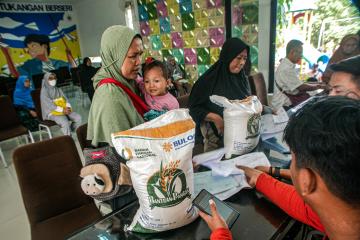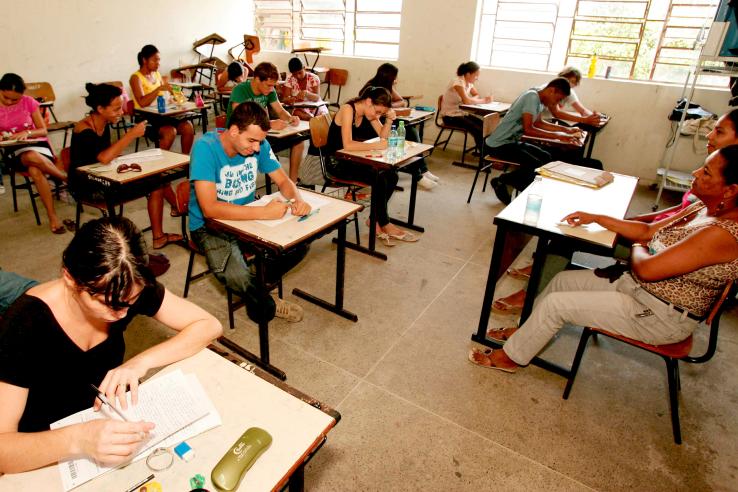
The Evidence Effect: How technology and smart policies can transform government service delivery

The work of government is challenging in high- and low-income countries alike. Delivering the right services at the right time, building a public workforce that is both motivated and capable, deciding how to allocate limited resources, and raising the revenue needed to fund it all—these are the everyday challenges of governance. And yet, how governments meet these challenges has profound consequences for people’s lives.
Today, new problems compound to make the work of government even harder: Governments must tackle poverty and address climate change while many are in the midst of debt and fiscal crises that were compounded by Covid. Many are investing scarce resources in digital infrastructure and new technologies, making rigorous evaluation more important now than ever.
Meanwhile, foreign assistance has become harder to secure for low- and middle-income countries. And trust in government is declining, while many citizens still don’t have access to basic public services like primary health care and social safety nets.
In our work at J-PAL we’ve identified many evidence-informed ways to increase state capacity and help make the hard work of governing more impactful. We share examples below of how to make tax systems more effective and fair, apply technology in smart ways to improve service delivery, and rethink private sector regulation.
This matters not only for governments, but for donors: Over time, governments that excel at funding, planning, and delivering services will require less foreign assistance.
Making tax systems more effective and fair
Governments need to raise resources to be able to deliver essential services, but effective taxation is a challenge. Governments in the world’s lowest-income countries collect only 10 percent of their GDP in taxes, compared to 40 percent in high-income countries.
There are some simple ways to increase revenues. Low-cost interventions like sending reminder messages to taxpayers, evaluated in 32 countries to date, have led to significant improvements in individuals’ and businesses’ tax compliance. Messages that are framed in simple terms and include a credible threat of enforcement are particularly effective, as is targeting messages to taxpayers most likely to evade.
Technology and cutting-edge data methods open new possibilities to make tax administration more effective and progressive—in other words, helping to ensure those with lower incomes or property values pay a lower percentage toward taxes. AI and machine learning hold potential to drive down the costs of tax administration, but should be tested carefully to ensure their effectiveness and reduce potential for inadvertent harm.
Many low-income country governments have reliable information for only a small subset of taxpayers. Some programs that tackle this information gap have shown initial success: For example, in the Democratic Republic of Congo, an evaluation of a simple machine learning algorithm trained on administrative data found that it was able to assess property values accurately and efficiently. A J-PAL-funded evaluation of a similar algorithmic approach in Senegal was more effective than bureaucrats in accurately valuing property taxes and avoiding potential bias.
Smart ways to use technology to improve service delivery
One of the most powerful applications of technology in government lies in monitoring and improving public service delivery. Digital tools can generate data on how services are performing and make it easier to collect, access and visualize this information, enabling supervisors to ensure frontline workers fulfill their responsibilities to citizens.
Evidence from India is particularly compelling. A J-PAL-funded evaluation found that government adoption of a digital app helped officials identify sources of payment delays in a national work program; access to the app significantly reduced wage payment delays to citizen workers, particularly in areas with worse baseline performance. Similarly, an evaluation led in part by J-PAL South Asia found that adoption of a mobile phone-based monitoring system in which a call center contacted farmers to verify whether they had received their government payments led to remarkable, cost-effective results—suggesting that this type of monitoring can be a cheap, simple, and flexible tool for improving last-mile service delivery at a large scale.
These results aren't limited to India. In Paraguay, we funded research that found that GPS-enabled cell phones transformed the effectiveness of agricultural extension agents by allowing supervisors to track where agents were, how long they spent in each location, and their activities with farmers. The result was a significant increase in the share of farmers visited, resulting in the Ministry of Planning advocating for expanded use of monitoring technology across more government ministries.
In Pakistan, replacing paper-based health inspection monitoring with a smartphone app reduced doctors’ absenteeism in clinics, though the effect was strongest where health officials faced less political pressure to protect doctors—a reminder that technology solutions must account for local contexts and politics. This is why rigorous testing through evaluation is essential: A J-PAL-funded evaluation of a similar program in Karnataka found limited impacts due to limitations in the government’s ability or willingness to enforce penalties.
AI and machine learning can transform service quality with tangible impacts for people
Cutting-edge technology has the potential to directly improve the efficiency and quality of essential government services. Take Letrus, a Brazilian AI-based platform that provides personalized feedback on high school students' essays. The platform frees up teachers’ time from grading essays so they can focus on personalized tutoring, helping improve writing skills for public school students preparing for university entrance exams. Based on positive evaluation results, the state of Espírito Santo scaled the AI-only version to all public high school seniors, with over 100,000 students now using the platform.
Technology also holds promise for better targeting and delivery of public benefits and social protection programs, including unconditional cash transfers, conditional cash transfers, food assistance, and “big push” programs like the Graduation approach. In a J-PAL funded project in Togo, for example, the government used machine learning algorithms and data from satellites and mobile phone networks to effectively identify vulnerable households to receive cash transfers during Covid, creating a rapid and cost-effective way to distribute urgent emergency aid.
Technology can give a boost to otherwise straightforward approaches to improving public services, and doesn't always need to be expensive or particularly high-tech. In Mexico City's judicial labor courts, providing information to workers about likely case outcomes calculated from an algorithm, and offering mediation services, helped educate them about the risks of drawn-out court cases and, in some cases, nearly doubled settlement rates before a case went to trial. This not only improved outcomes for workers, but also helped reduce the court's multi-year case backlog. The success of this approach informed a broad reform of Mexican national labor law.
Smart regulation: Making markets work for policy goals
Governments typically regulate industries using “command-and-control” approaches, creating rules that companies must adhere to. But these often fall short, especially when governments are unable to effectively monitor and/or objectively enforce penalties. New evidence shows how governments can harness market mechanisms to make regulation more effective.
Gujarat's pioneering emissions trading scheme is a prime example. Launched by the Gujarat Pollution Control Board, this cap-and-trade system allows the regulator to set total pollution limits while giving factories the flexibility to buy and sell permits to stay below the cap. This market-based approach has proven more effective and cost-effective than traditional command-and-control regulation, monitoring, and enforcement in improving air pollution: Participating firms substantially reduced their particulate matter emissions without large increases in abatement costs.
Priorities for development: Invest in building state capacity
The role of technology in governance presents both tremendous opportunities and the need to proceed thoughtfully. For governments to leverage technology effectively, they first need good administrative data. With good data, AI technologies offer new possibilities for reducing constraints in effectiveness and supply of frontline workers, improving targeting of government programs, and avoiding bias in service delivery.
Yet these technologies must be tested and scaled carefully to ensure success and avoid harmful impacts. This is where J-PAL's approach of rigorous evaluation becomes essential—we need to understand not just whether interventions work, but where, why, and under what conditions. Our new Project AI Evidence, launched in collaboration with Google.org and Schmidt Futures, aims to do just that, working with governments and other partners to find the most promising social impact solutions for scale.
Many of the J-PAL funded studies we mention above were supported by our Governance Initiative, which focuses on finding evidence-informed solutions that strengthen state capacity. A consortium of donors have supported dozens of policy-relevant studies and scaling partnerships over the years, led by the UK’s Foreign, Commonwealth and Development Office (FCDO)—helping pilot, test, and scale innovative approaches to more effective governance that improves peoples’ lives.
Beyond research, our new Alliance for Data, Evaluation, and Policy Training (ADEPT) aims to build bureaucrats’ skills in data analysis and decision-making through customized courses, knowledge sharing, and academic programs. Through partnerships with governments and other learning institutions, ADEPT aims to empower civil servants and leaders to champion a culture of effective, evidence-informed policymaking that outlasts bureaucratic shifts and changes in administrations.
As my colleagues recently noted, low- and middle-income country governments are at the center of the fight against poverty and invest far more in their own social programs than all foreign aid combined. But multilaterals like the World Bank and IDB, bilaterals like USAID and FCDO, foundations like Gates and Hewlett, philanthropists, and evidence organizations like J-PAL and IPA have played key complementary roles in building state capacity. These organizations help unlock opportunities for evaluations of policy-relevant research like what we’ve shared here, and through formal training programs and informal collaboration and knowledge sharing of global best practices.
Combining low-tech solutions with strategic use of technology and smart market alignment, all of which have been rigorously evaluated to be effective, can help governments build capacity to serve their citizens better. The tools are available. Now we need the will to act on it.



